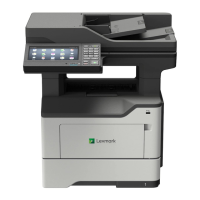• Hard disk memory—Some printers have a hard disk drive installed. The hard disk is designed for printer-
specific
functionality and cannot be used for long‑term storage of data that is not print-related. The hard
disk does not let users extract information, create folders, create disk or network
file
shares, or transfer FTP
information directly from a client device. The hard disk can retain buered user data from complex print
jobs, form data, and font data.
The following parts can store memory:
• Printer control panel
• User interface controller card (UICC)
• Controller board
• Optional hard disks
Note: The printer control panel and controller board contain NVRAM.
Erasing printer memory
To erase volatile memory, turn o the printer.
To erase nonvolatile memory, do the following:
1 From the control panel, navigate to Settings > Device > Maintenance > Out of Service Erase > Sanitize all
information on nonvolatile memory.
2 Select Sanitize all information on nonvolatile memory, and then select ERASE.
3 Follow the instructions on the screen.
To erase hard disk memory, do the following:
1 From the control panel, navigate to Settings > Device > Maintenance > Out of Service Erase > Sanitize all
information on hard disk.
2 Select Sanitize all information on hard disk, and then select ERASE.
3 Follow the instructions on the screen.
Note: This process can take from several minutes to more than an hour, making the printer unavailable for
other tasks.
If a hard disk is replaced, then do the following:
1 Remove the hard disk, and then return it to the customer.
2 Request the customer to sign the Customer Retention form.
Note: You can get printed copies of the form from your Lexmark partner manager.
3 Take a photo of the signed form, and then upload it to the Service Request debrief tool.
4 Fax or e-mail the signed form to the number or e-mail address shown at the bottom of the form.
Handling ESD‑sensitive parts
Many electronic products use parts that are known to be sensitive to electrostatic discharge (ESD). To prevent
damage to ESD-sensitive parts, do the following:
• Turn o the printer before removing logic boards.
• Keep the parts in their original packing material until you are ready to install them into the printer.
7018
Parts removal
201

